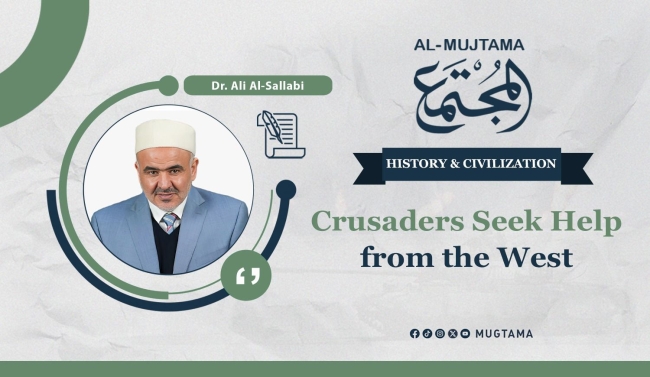Crusaders Seek Help from the West
As soon as the fighting ended at the Battle of Hattin and the Crusaders faced their devastating loss, messengers were swiftly dispatched to Western Europe to inform the kings and princes about the dire situation of the Crusaders in the East. More messengers followed suit after the conquest of Jerusalem.
The reality is that this loss and the conquest triggered a violent reaction in Western society, which was horrified by the news of these two disasters. The Christians in the West believed that these calamities occurred because they had neglected to respond to the repeated pleas for help from the Kingdom of Jerusalem in recent years. The Crusaders who gathered in the city of Tyre realized that unless reinforcements arrived from the West, their chances of holding onto Tyre would diminish, as all hope of regaining the lost territories had vanished.
Conrad of Montferrat quickly sent Joscius, the Archbishop of Tyre, to Western Europe in the middle of 583 AH, during the summer of 1187 CE, to request urgent assistance from the Pope, the kings of Europe, and their princes.
Joscius arrived in Sicily and met with its king, William II, who responded to this call after being shocked by the news that Joscius brought about the catastrophe that had befallen the Crusaders in the East. Since William was already at war with Byzantium, he made peace with the Byzantine Emperor Isaac II Angelos in Muharram 584 AH/March 1188 CE to focus on the Crusader cause. He then sent a fleet carrying several hundred knights to Tripoli under the command of the Sicilian grand admiral Margaritus of Brindisi, successfully preventing Salah Ad-Deen from capturing Tripoli. (Source: “The Ayyubid History in Egypt, the Levant, and the Jazira Region” by Muhammad Suhail Taqqosh, p. 176).
Joscius then traveled from Sicily to Rome, accompanied by a Sicilian delegation, to explain to Pope Urban III the true situation of the Crusaders in the Levant. The Pope, unable to bear the shock, died of grief on 14th Sha'ban 583 AH/October 1187 CE. His successor, Gregory VIII, immediately contacted the kings of England and France, as well as the Holy Roman Emperor, urging them to set aside their differences and unite their forces to fight against the Muslims. Although Pope Gregory VIII died on 13th Shawwal/17th December before seeing the fruits of his efforts, his successor, Clement III (583-587 AH/1187-1191 CE), quickly contacted the German Emperor Frederick I Barbarossa and convinced him to participate in a Crusade to the East. At this time, Joscius had moved westward to meet with the kings of France and England, Philip Augustus and Henry II. He met with them in Gisors on the border between Normandy and France, convincing them to set aside their intense differences and encouraging them to make peace and join together in a Crusade.
However, they delayed in implementing this, and the war between them resumed. Henry II, King of England, died in 585 AH/1189 CE and was succeeded by his son, Richard the Lionheart, Duke of Poitou, who made peace with the French king and prepared to embark on a joint campaign to the East with him (Source: “Salah Ad-Deen al-Ayubi” by Ali Al-Sallabi, p. 473).
The role of Christian religious leaders during times of crisis becomes evident through the actions of Joscius and the Pope. Here, we draw an important lesson: scholars, jurists, preachers, thinkers, writers, and politicians from our own Ummah should move beyond mere feelings of regret and despair during crises and calamities and instead, diligently work toward what pleases Allah and His Messenger. This includes utilizing leadership skills, persuasive abilities, effective planning, and presenting a visionary and civilizational approach for the elevation of Allah’s religion and repelling invaders.
The Crusaders arrived in the Levant in vast numbers beyond counting. This is evidenced by a letter sent by Salah Ad-Deen to the Abbasid Caliph in Baghdad in 586 AH/1190 CE, in which he reported: Islam has been afflicted by people who have embraced death, responded to the call, abandoned their loved ones and homelands, forsaken the familiar, family, and homes, ventured into the seas, and sacrificed their lives—all in obedience to their priests. Christians from all groups and nationalities have emerged. Those unable to join the fight themselves have equipped those who can with resources and wealth.
Women also participated in the Third Crusade. Some women accompanied knights and took responsibility for all their needs of supplies and equipment. For example, Abu Shama and others mentioned that in 585 AH/1189 CE, a noble Christian woman arrived by sea in the Levant with 500 knights and their horses, as well as their followers. She provided everything they needed, and they would ride when she rode, charge when she charged, and leap when she leaped. Some women even wore armor and dressed as men to take part in battles themselves, believing that their actions were acts of worship. Others joined to provide medical aid to strangers and to please the Crusaders by offering themselves for their enjoyment, to prevent boredom from seeping into the hearts of the fighters (Source: “Salah Ad-Deen and the Crusaders” by Abdullah al-Ghamidi, p. 238).
Meanwhile, William II, King of Sicily, hastened to send a fleet in 585 AH/1189 CE consisting of sixty ships with ten thousand soldiers, led by a naval commander named “Margaritus.” The fleet sailed to the city of Tyre, then returned to Tripoli, but was of little benefit to the Crusaders because the supplies it carried were insufficient for the men aboard (Source: “Mufarrij Al-Kurub Fi Akhbar Bani Ayyub” by Jamal Ibn Wasil, vol. 2, p. 558).
-------------------------------------------------------------


